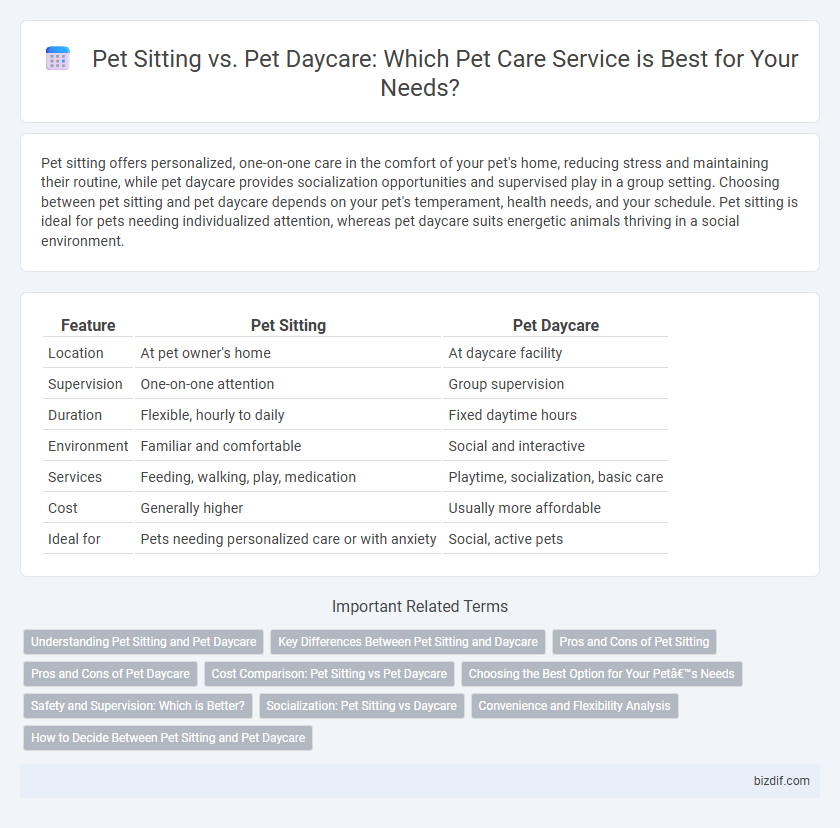Pet sitting offers personalized, one-on-one care in the comfort of your pet's home, reducing stress and maintaining their routine, while pet daycare provides socialization opportunities and supervised play in a group setting. Choosing between pet sitting and pet daycare depends on your pet's temperament, health needs, and your schedule. Pet sitting is ideal for pets needing individualized attention, whereas pet daycare suits energetic animals thriving in a social environment.
Table of Comparison
| Feature | Pet Sitting | Pet Daycare |
|---|---|---|
| Location | At pet owner's home | At daycare facility |
| Supervision | One-on-one attention | Group supervision |
| Duration | Flexible, hourly to daily | Fixed daytime hours |
| Environment | Familiar and comfortable | Social and interactive |
| Services | Feeding, walking, play, medication | Playtime, socialization, basic care |
| Cost | Generally higher | Usually more affordable |
| Ideal for | Pets needing personalized care or with anxiety | Social, active pets |
Understanding Pet Sitting and Pet Daycare
Pet sitting offers personalized, one-on-one care for pets in their familiar home environment, reducing stress and maintaining routine. Pet daycare provides supervised group socialization and activity during the day, ideal for pets needing interaction and exercise outside the home. Choosing between pet sitting and pet daycare depends on a pet's individual temperament, health needs, and owner's schedule.
Key Differences Between Pet Sitting and Daycare
Pet sitting involves personalized, one-on-one care for pets in their own home, ensuring familiar surroundings and tailored attention to individual needs. In contrast, pet daycare offers socialization opportunities in a group setting, often at a dedicated facility with structured activities and supervision. Understanding these key differences helps pet owners choose between personalized care and social engagement based on their pet's temperament and requirements.
Pros and Cons of Pet Sitting
Pet sitting offers personalized care in the pet's familiar environment, reducing stress and maintaining routine, which is ideal for pets with anxiety or special needs. Unlike pet daycare, it eliminates exposure to other animals, lowering the risk of infections and behavioral issues but may lack socialization opportunities for highly social pets. However, pet sitting can be more costly and depends heavily on the sitter's reliability and experience, making thorough vetting essential.
Pros and Cons of Pet Daycare
Pet daycare offers structured socialization and supervised playtime, which can improve a pet's behavior and reduce separation anxiety. However, it may expose pets to contagious diseases and stress from a noisy, crowded environment. Cost is typically higher than pet sitting, and some pets may not adapt well to group settings.
Cost Comparison: Pet Sitting vs Pet Daycare
Pet sitting costs vary widely depending on the sitter's experience and location, typically ranging from $15 to $40 per visit, whereas pet daycare fees average between $20 and $50 per day. Pet sitting often proves more cost-effective for pet owners who only need occasional care, while daycare is more economical for daily or extended service needs. Comparing both options, pet sitting offers personalized attention with flexible pricing, whereas daycare provides socialization and structured activities at a consistent rate.
Choosing the Best Option for Your Pet’s Needs
Pet sitting offers personalized, one-on-one care in a familiar environment, ideal for pets with anxiety or special health requirements. Pet daycare provides socialization and structured activities, benefitting pets needing regular exercise and interaction with others. Evaluating your pet's temperament, health, and daily routine helps determine whether the individualized attention of pet sitting or the engaging atmosphere of pet daycare better suits their needs.
Safety and Supervision: Which is Better?
Pet sitting offers personalized, one-on-one supervision tailored to an individual pet's needs, reducing stress and minimizing exposure to illnesses found in group settings. Pet daycare provides constant social interaction and monitoring but may increase risks of injury or disease transmission due to numerous pets sharing the same space. Choosing between pet sitting and pet daycare depends largely on prioritizing safety through controlled environments versus social engagement under professional oversight.
Socialization: Pet Sitting vs Daycare
Pet sitting offers personalized one-on-one socialization tailored to the pet's comfort level and routine, reducing stress and anxiety. Pet daycare provides extensive social interaction with multiple animals, promoting play and behavioral development in a supervised environment. Choosing between pet sitting and daycare depends on the pet's social needs, temperament, and preference for individualized attention versus group engagement.
Convenience and Flexibility Analysis
Pet sitting offers unparalleled convenience by allowing pets to stay in their familiar home environment, eliminating the stress and hassle of transportation required for pet daycare. This service provides flexible scheduling tailored to owners' specific needs, accommodating varying routines and last-minute changes more easily than fixed daycare hours. Pet daycare, while beneficial for socialization, typically requires drop-off and pick-up during set times, limiting flexibility compared to personalized in-home care.
How to Decide Between Pet Sitting and Pet Daycare
Choosing between pet sitting and pet daycare depends largely on your pet's specific needs, temperament, and social preferences. Pet sitting offers personalized, one-on-one care in the pet's familiar environment, reducing stress for anxious or elderly animals, while pet daycare provides socialization, structured activities, and supervised playtime ideal for energetic, social pets. Evaluating your pet's behavior, daily routine, and comfort level with other animals helps determine the better option for maintaining their health and happiness.
Pet sitting vs Pet daycare Infographic

 bizdif.com
bizdif.com